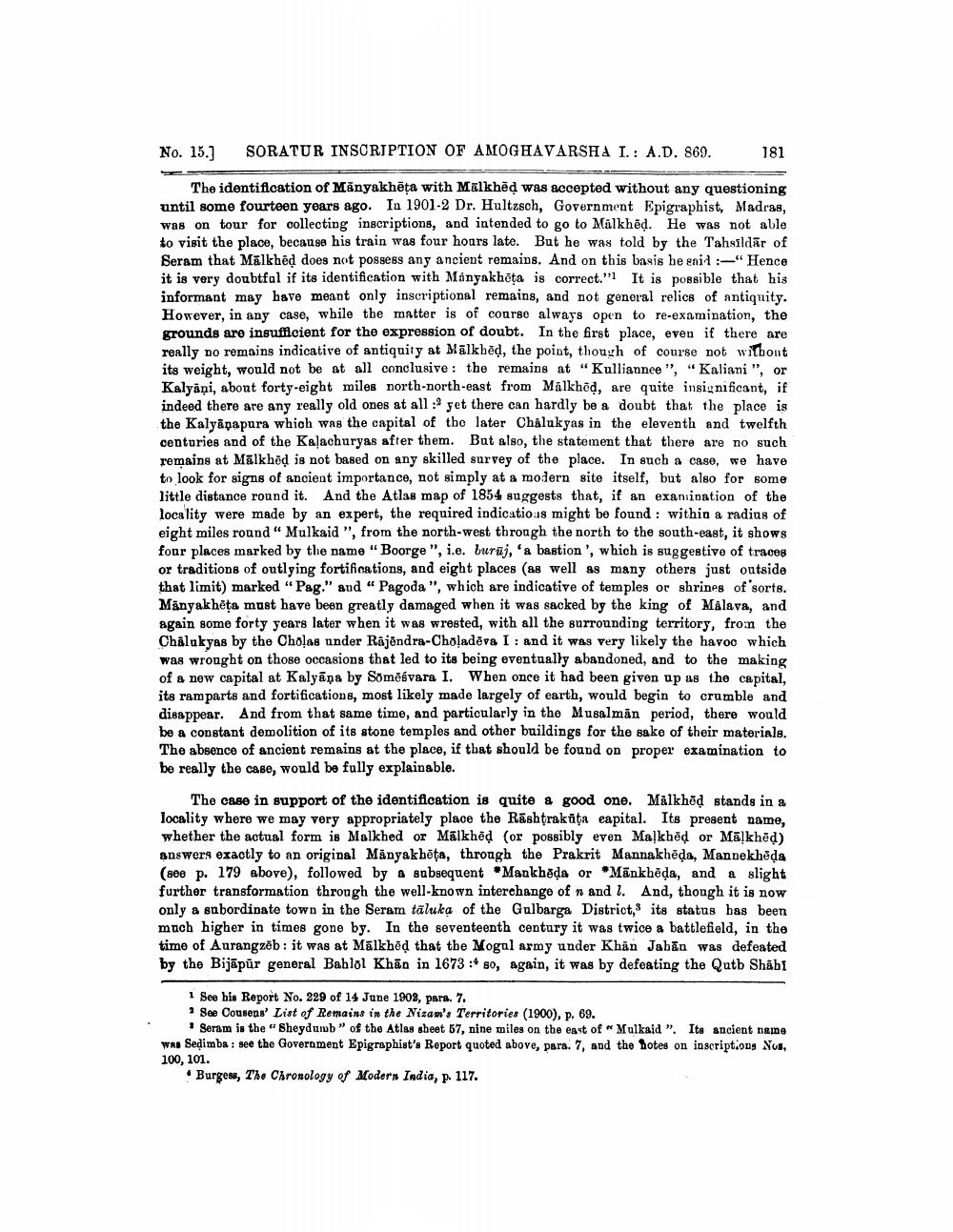________________
No. 15.]
SORATUR INSCRIPTION OF AMOGHAVARSHA I.: A.D. 869.
The identification of Manyakheta with Malkhed was accepted without any questioning until some fourteen years ago. In 1901-2 Dr. Hultzsch, Government Epigraphist, Madras, was on tour for collecting inscriptions, and intended to go to Malkhed. He was not able to visit the place, because his train was four hours late. But he was told by the Tahsildar of Seram that Malkhed does not possess any ancient remains. And on this basis he said :-" Hence it is very doubtful if its identification with Manyakheta is correct." It is possible that his informant may have meant only inscriptional remains, and not general relics of antiquity. However, in any case, while the matter is of course always open to re-examination, the grounds are insufficient for the expression of doubt. In the first place, even if there are really no remains indicative of antiquity at Malkhed, the point, though of course not without its weight, would not be at all conclusive: the remains at "Kulliannee", "Kaliani ", or Kalyani, about forty-eight miles north-north-east from Malkhed, are quite insignificant, if indeed there are any really old ones at all: yet there can hardly be a doubt that the place is the Kalyanapura which was the capital of the later Chalukyas in the eleventh and twelfth centuries and of the Kalachuryas after them. But also, the statement that there are no such remains at Mālkheḍ is not based on any skilled survey of the place. In such a case, we have to look for signs of ancient importance, not simply at a modern site itself, but also for some little distance round it. And the Atlas map of 1854 suggests that, if an examination of the locality were made by an expert, the required indicatious might be found: within a radius of eight miles round" Mulkaid ", from the north-west through the north to the south-east, it shows four places marked by the name "Boorge", i.e. buruj, 'a bastion', which is suggestive of traces or traditions of outlying fortifications, and eight places (as well as many others just outside that limit) marked "Pag." and "Pagoda ", which are indicative of temples or shrines of sorts. Manyakhēta must have been greatly damaged when it was sacked by the king of Malava, and again some forty years later when it was wrested, with all the surrounding territory, from the Chalukyas by the Cholas under Rajendra-Chōladeva I: and it was very likely the havoc which was wrought on those occasions that led to its being eventually abandoned, and to the making of a new capital at Kalyana by Someśvara I. When once it had been given up as the capital, its ramparts and fortifications, most likely made largely of earth, would begin to crumble and disappear. And from that same time, and particularly in the Musalman period, there would be a constant demolition of its stone temples and other buildings for the sake of their materials. The absence of ancient remains at the place, if that should be found on proper examination to be really the case, would be fully explainable.
181
The case in support of the identification is quite a good one. Mālkheḍ stands in a locality where we may very appropriately place the Rashtrakuta capital. Its present name, whether the actual form is Malkhed or Malkheḍ (or possibly even Malkhed or Mālkhed) answers exactly to an original Manyakheta, through the Prakrit Mannakheda, Mannekheda (see p. 179 above), followed by a subsequent Mankheda or *Mankheda, and a slight further transformation through the well-known interchange of n and l. And, though it is now only a subordinate town in the Seram taluka of the Gulbarga District, its status has been much higher in times gone by. In the seventeenth century it was twice a battlefield, in the time of Aurangzeb: it was at Malkhed that the Mogul army under Khan Jahan was defeated by the Bijapur general Bahlōl Khan in 1673: so, again, it was by defeating the Qutb Shabi
1 See his Report No. 229 of 14 June 1903, para. 7.
2 See Cousens' List of Remains in the Nizam's Territories (1900), p. 69.
Seram is the "Sheydumb" of the Atlas sheet 57, nine miles on the east of "Mulkaid". Its ancient name was Seḍimba: see the Government Epigraphist's Report quoted above, para. 7, and the notes on inscriptions Nos, 100, 101.
Burgess, The Chronology of Modern India, p. 117.




